Gear School 2009: Essentials
From sleeping pads to trekking poles, we'll have you good to go in no time.
SLEEPING PADS
Use
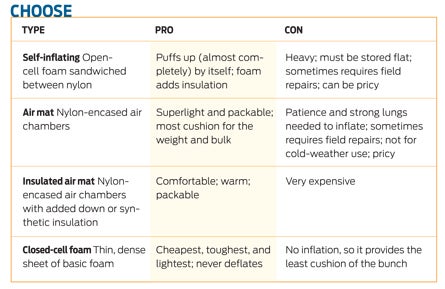
- Tempted to puff up your self-inflating pad? Not so fast–the moisture in your breath can get trapped inside the pad, encouraging mildew. To make your bed, simply open the valve and lay it out flat for an hour; air will get in by itself (and you can top it off with a few breaths).
- To deflate a self-inflater or air mat, open the valve and start rolling on the opposite end, squeezing air out and kneeling on the roll as you go. When you reach the end, close the valve so it doesn’t puff back up, and stash it in its stuffsack.
- Self-inflating pads and air mats double as comfy camp chairs with the Big Agnes Cyclone SL Chair Kit ($40, bigagnes.com), one of last year’s Editors’ Choice honorees.
- To store any inflatable pad, leave it inflated with the valve open to encourage circulation.
Fix
Problem Leaky valve
Solution Run a thin bead of Seam Grip around the valve at the spot where it protrudes from the pad.
Problem Hole in an inflatable pad
Solution First step: Find the puncture by inflating the pad, then submerging it in a stream to find the telltale air bubbles. No stream? Pour water on the pad and wipe every last inch with a bandana until bubbles appear. Circle the spot with a marker and deflate the pad. To patch a tiny hole, apply a drop of Seam Grip. For larger holes, mix a few drops of water with Seam Grip and apply to the gash, extending 1/2-inch around its edges. Stick a nylon patch with rounded edges to the hole and let dry for at least 30 minutes.
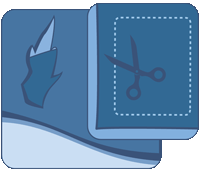
3 New Uses for Old Closed-Cell Pads
Camp seat: Cut a piece and use it to insulate your butt on cold or snowy ground.
Soup/tea cozy: Tape a scrap around your water bottle.
Stove insulation: Wrap a square in duct tape and use as a cooking platform. TREKKING POLESUse
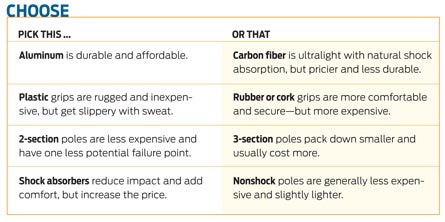
- On level terrain, adjust poles so that your forearms are parallel to the ground when you’re standing still with your hands on the grips (neutral position). When going uphill, shorten poles so forearms are tilted slightly below neutral. When descending, extend them so arms are slightly above neutral. See a video demo at backpacker.com/trekpole.
Fix
Problem Collapsing pole
Solution Adjustable pole won’t stay adjusted? A dirty or loose interior expander nut could be to blame. Fix it by unscrewing the bottom pole section beyond the “stop” mark to expose the nut. Wipe away dirt and manually tighten if it’s loose.
Problem Lost/broken basket
Solution In a pinch, replace it with the plastic lid from an insulated mug. Heat the tip of a knife over your stove, then cut an “x” in the center of the lid (just big enough to let the pole through). Position the lid on the pole, then wrap duct tape around the bottom of the pole to hold lid in place.
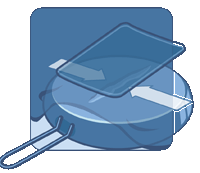
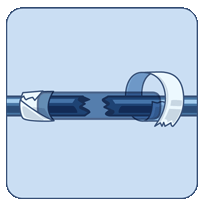
STOVESUse
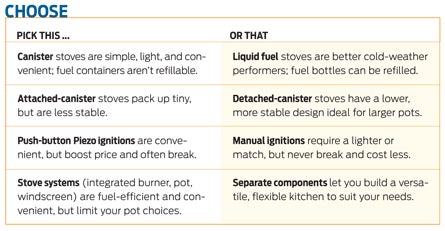
- Priming liquid fuel stoves requires practice and varies slightly from stove to stove, but here’s the gist: Open the valve to allow a bit of fuel to flow into the primer cup. Close the valve (or fuel will keep flowing and you’ll end up with a fireball!), light the fuel, and let it burn for a few seconds. When the flame is almost dead, open the valve again and the stove will puff to life. It may be a few minutes before the hot, blue flame kicks in.
- Heat meals faster by using a windblock, which boosts efficiency and improves boil time. Buy an aluminum screen to use with liquid fuel stoves, or make one out of several layers of heavy-duty foil or an oven liner. Never use a windscreen with a canister stove; it can create too much heat and melt controls. Instead, site your camp kitchen behind rocks or trees, or use your backpack, pot lids, or stacked rocks to block wind.
Fix
Problem Fuel won’t pressurize when pumping
Solution Your pump cup could be dried out. Unscrew the stove’s pump assembly, find the tiny circle of leather or neoprene, and moisten it with olive oil, lip balm, or saliva.
Problem Weak or sputtering flames
Solution White-gas models struggle when the burner parts and innards get sooty. Periodically take apart your stove (following the manual’s instructions) and wipe down the parts with a rag sprayed with WD-40. Clean the fuel line by removing the cable, wiping it down, and reinserting it into the line. Using short, quick strokes, scour the line clean (as if you were using a pipe cleaner), and reassemble.
Estimate Your Fuel Needs
In the summer, plan on using 5.5 ounces of liquid fuel and 2 to 3 ounces of canister fuel per person per day. Need to melt snow? Triple that number.
WATER TREATMENT
Use
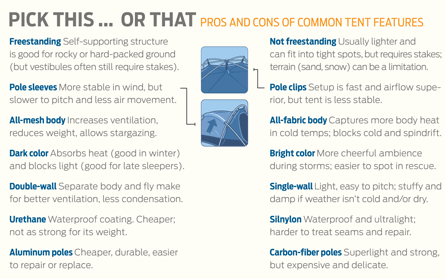
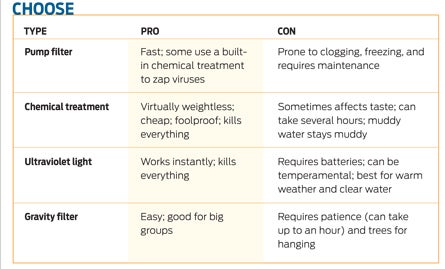
- Even the best filters can get trashed if you pump silty water. If your only water source is dirty or cloudy, attach a prefilter to the intake hose (some are sold separately), strain water through a bandana before filtering, or let sediment settle to the bottom of a bucket, pot, or plastic jug.
- Get your water from standing pools rather than swift currents (which stir up debris and microbes), and take it upstream of campsites. Safest sources: headwaters, high-country ponds, and glacial melt. Warning signs: farm runoff, hoofprints, mine tailings–even TP.
Problem Leaking input hose
Solution Locate the hole and simply wrap with duct tape. If the hose ends split, snip off the damaged end and reattach the fixture.

Problem Sluggish output
Solution First, an ounce of prevention. Disinfect at the start and end of each season by pumping a bleach solution (one capful mixed into one quart of tap water) through the filter. If efficiency dips later, it’s time for a cleaning. Ceramic filter elements can be scrubbed with a stiff brush, but resin or fiber filters must be backwashed. Technique varies from filter to filter, so check your manual.
WARM AND DRY
Never let leftover water freeze inside your filter; ice can make the filter element crack. Keep it warm by wrapping it in a T-shirt or towel and stashing it in your bag at night. At home, store the filter in a breathable mesh bag so moisture can fully evaporate.